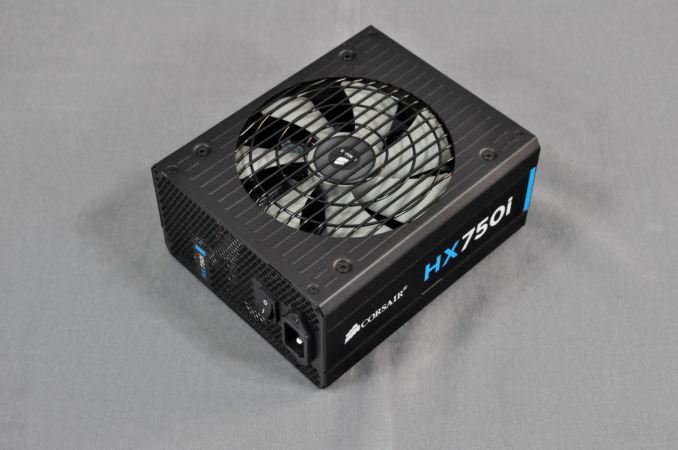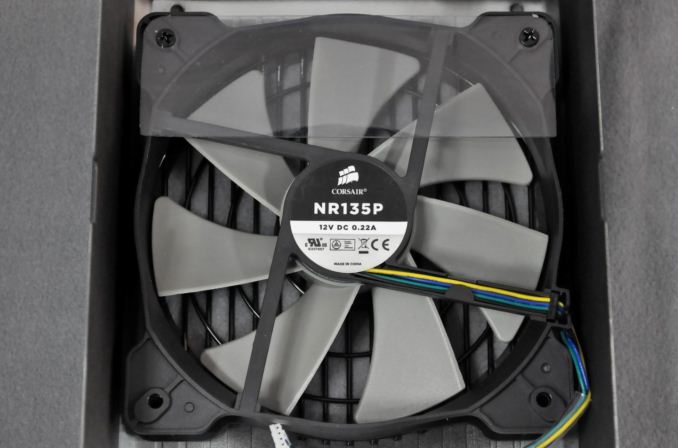Corsair HX750i Power Supply Review
by E. Fylladitakis on January 14, 2015 10:00 AM EST- Posted in
- Cases/Cooling/PSUs
- Corsair
- PSUs
- HXi Series
External Appearance
Visually, the Corsair HX750i stands out from the crowd. It's housed in a 180mm long chassis, which is considerably longer than a standard ATX chassis. Such a long chassis could be a problem in compact cases designs but it is not likely that any modern ATX tower case would not have enough space to accommodate the HX750i. The body has been sprayed with a satin black paint and decorative stickers cover the largest portion of its two sides. Further aesthetic improvements include chamfered edges and embossed parallel ridges aligned with the fan's finger guard design. The sticker with the specifications of the PSU can be found on the top of the chassis (opposite the fan).
The front of the chassis is littered with the connectors for the modular cables. The CPU and PCI Express cables share the same connectors, while the split 10-14 pin connector is for the 24-pin ATX cable and the smaller connectors are for SATA/Molex cables. There are also two connectors for the Corsair Link interface, one Mini-USB for direct connection to an internal USB header or a four-pin PMBus cable for connection to a Commander unit.
Internal Design
A grey blade 135mm fan takes care of the cooling that the HX750i requires at higher loads. At lower loads and depending on the temperature, the fan of the HX750i will not operate at all. It has a rifle bearing and a maximum speed of about 1600 RPM. With the UL number pointing back to Corsair, we cannot identify the OEM of the fan, as Corsair appears to be the manufacturer of these fans.
The interior of the HX750i is where things become truly interesting. The HX750i is based on a Channel Well Technologies (CWT) design, a company that goes way back with Corsair and who built many of their earlier units. It is also nearly identical with the platform used for the RM series. The heatsinks are not much more than simple quadrangular metallic slabs with minimal heat dissipation surface, but they ought to be adequate for the cooling needs of the very efficient HX750i, especially since the same heatsinks were enough for the RM1000.
The 400V / 390μF APFC capacitors are supplied by Nippon Chemi-Con, as is every other electrolytic capacitor inside the HX750i. The polymer capacitors come from Apaq, a Taiwanese manufacturer. The quality of the components appears to be the only major improvement over the RM series, in which we found components mainly from Taiwanese manufacturers instead. The filtering stage begins at the back of the AC receptacle, where we found two of the Y capacitors. There are a total of six Y capacitors, three X capacitors, and two filtering inductors -- a reasonable amount of components for a good filtering stage.
As far as the build quality goes, CWT did a magnificent job with the HX750i. The soldering job is excellent, competing with the best that we have ever seen. If not for a little excessive use of solder at a few points, it would grade as immaculate. The factory used a lot of glue to secure most components, improving the mechanical cohesion of the unit. An extra application of lacquer and glue can be seen on the inductors, as well as heatshrink/tape covering, most likely to minimize the chance of vibration-generated noise (also known as "coil whine").
























32 Comments
View All Comments
icebox - Wednesday, January 14, 2015 - link
I had this for a few months now, it's an excellent PSU.But I'm curious about which way it should be mounted:
Fan side up so heat can escape easily when the fan is off or fan side down ?
RedEye9 - Wednesday, January 14, 2015 - link
I have a bottom mounted 750 watt corsair ps with a load/temp activated fan. It would cycle when mounted fan side down to blow out accumulated heat. I turned it fan side up and the fan never cycles. (silence)jonnyGURU - Friday, January 16, 2015 - link
^^ This. Fan down and the heat will rise into the PSU PCB until the fan kicks in. Fan up and the heat rises out of the PSU housing and the fan will hardly ever kick in.While the Corsair marketing says that the PSU's fan doesn't turn on until 30% load, that really depends on multiple conditions. The fan controller used in these uses an algorithm of load, temperature and duration to determine when the fan should turn on and at what speed.
EzioAs - Wednesday, January 14, 2015 - link
Doesn't really matter actually but if your chassis has a filtered bottom intake, might as well mount it with the fan facing down.Strunf - Thursday, January 15, 2015 - link
Better with the fan facing up as you said the heat will escape easily and the fan will hardly ever spin since you don't use too much power most of the time.malkolm - Wednesday, January 14, 2015 - link
Nice review, thx for it!Actually i do not agree with you mentioning, that a 750W System is intrinsically so load that the noise of a PSU doesnt matter at all. I dont know if it's a european thing, but at least here the ultra-low noise market is growing extraordinarily, meaning more and more people are build machines, even their top-end gaming rigs, and demand it to be litteraly inaudible.
Really big tower coolers, custom GPU designs and of course custom water cooling (again a rapidly growing market in the EU) help with this, but the one thing most people end with is the annoying scenario of having the PSU left as the only source of noise. Of course one can buy one of these semi-passive devices designed for 1500Watts to power their 600Watts gaming rig just to make sure its fan doesnt start to run, but thats not a viable option for most users.
There are only a few companies who had an ear for those users, with beQuiet! (German brand/company i think) beeing to most renown and most recommended manufacturer for this market. I guess Corsair is also good advised to focus more on their accoustics.
Kutark - Wednesday, January 14, 2015 - link
Using a 1500w PSU to make it more silent is just irresponsible. PSU's have much better efficiency when they're between about 40 and 70% load. Getting a 1500w psu like that, despite the additional cost with buying, generally means you will be operating at a load level that is moderately to highly inefficient.Dr.Neale - Saturday, January 17, 2015 - link
Not if you get a 80+ Titanium rated semi-passive 1500W PSU, e.g. Corsair AX1500i. It's very, very quiet (with the fan facing upwards, of course).Of course, the 80+ Platinum SeaSonic 520W fanless PSU (SS-520FL2) is totally silent, with no coil whine to speak of, and 1/3 the price. It's good for a quiet single-GPU build.
N.B. Low ripple is especially important for the longevity of your computer components. And the lower the ripple, the higher the quality, and price.
That's my experience, anyway.
EzioAs - Wednesday, January 14, 2015 - link
Doesn't really matter actually but if your chassis has a filtered bottom intake, might as well mount it with the fan facing down.EzioAs - Wednesday, January 14, 2015 - link
I was actually trying to reply to icebox...when are we going to get an edit fuction?